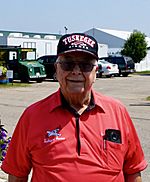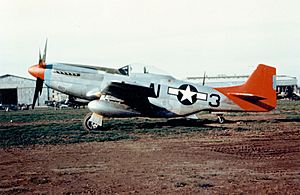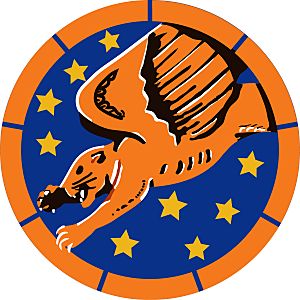George Hardy (Tuskegee Airman) facts for kids
Quick facts for kids
Lieutenant Colonel
George Hardy
|
|
|---|---|
 |
|
| Birth name | George Edward Hardy |
| Born | June 8, 1925 Philadelphia, Pennsylvania, U.S. |
| Died | September 26, 2025 (aged 100) |
| Allegiance | |
| Service/ |
United States Army Air Force |
| Years of service | 1943–1971 |
| Rank | Lieutenant Colonel |
| Unit | 332nd Fighter Group |
| Awards |
|
| Spouse(s) | 2nd wife Bonnie |
George Hardy (June 8, 1925 – September 26, 2025) was a brave American pilot and military officer. He was known for his service in three major wars. During World War II, he was part of the famous Tuskegee Airmen. He flew 21 important missions. Later, in the Korean War, he piloted a bomber on 45 missions. He also flew 70 missions in the Vietnam War, using a special AC-119K gunship.
Contents
Early Life and Dreams
George Hardy grew up in Philadelphia, Pennsylvania. His parents were Edward Hardy and Alma Vargas. During his childhood, he experienced unfair treatment because of his race. This was a time when many parts of society, including the military, were separated based on race. George finished high school in 1942. He wanted to join the military, just like his older brother who joined the U.S. Navy. In 1943, George joined the Army Air Corps. Even in the military, he faced challenges and unfairness from some leaders. After World War II, George studied at New York University School of Engineering and Science. He dreamed of becoming an engineer and didn't originally plan to stay in the Air Force.
George Hardy's Education
George Hardy was a lifelong learner. Here are some of the schools he attended and degrees he earned:
- Walter George Smith School
- South Philadelphia High School
- He earned a Bachelor of Science degree in electrical engineering.
- He also received a Master of Science degree in systems engineering-reliability from the U.S. Air Force Institute of Technology.
- Later, he was given an Honorary doctorate of public service from Tuskegee University.
A Life of Military Service
Serving in World War II
In 1943, when George was 17, he joined the Army Air Corps. He started his flight training at Tuskegee Army Air Field. This was a special place where African American pilots were trained. He then went to Keesler Army Air Field for basic training. By 1944, he became a second lieutenant in the United States Army. George learned to fly powerful single-engine fighter planes. He completed his combat training in 1945 and was sent to Italy. He was one of only about 450 Tuskegee Airmen pilots who served overseas. George flew 21 combat missions over Germany in 1945. He often flew a P-51D Mustang, protecting larger B-17 and B-24 bombers. After the war, he returned to Tuskegee to help train new pilots.
Flying in the Korean War
George Hardy was called back to serve in the military in 1948. He went to Keesler Air Force Base and then to Guam. Later, he was stationed at Kadena Air Base in Okinawa. There, he flew a B-29 bomber. He completed 45 combat missions over Korea. During this time, he again faced unfair treatment from some officers. One officer, Lt. Col. Fred W. Miller, unfairly removed George from a mission. Sadly, that B-29 plane was later shot down. However, later on, the same officer, Miller, changed his mind. He came to respect George Hardy greatly and saw him as one of his best leaders.
Missions in the Vietnam War
George Hardy continued his service in the Vietnam War. He flew 70 missions in a special C-119 gunship. These missions often happened at night. He used advanced infrared technology to find and stop supply routes and convoys. These were used by North Vietnam in countries like Laos and Cambodia.
Awards and Recognition
Lieutenant Colonel George Hardy received many important awards for his bravery and service:
- The Air Medal
- The Commendation Medal with one Oak Leaf Cluster
- The Congressional Gold Medal in 2007
- The Distinguished Flying Cross with Valor
- He was inducted into the Florida Veterans Hall of Fame.
- He received 11 Oak Leaf Clusters for his Air Medals.
- Tuskegee University awarded him an Honorary Doctorate Degree of Public Service in 2006.
- He was also honored in the South Philadelphia High School Cultural Hall of Fame.
A Legacy of Inspiration
After retiring from the military, George Hardy dedicated many years to sharing his story. He traveled across the country, telling people about the Tuskegee Airmen. He spoke about their brave fight against unfair treatment and their amazing combat missions in World War II. He also shared stories about their careers after the war.
George Hardy was one of the very last surviving members of the original Tuskegee Airmen. He was one of the few who graduated from Tuskegee Army Air Field as a single-engine fighter pilot. A special P-51D plane, which he flew in combat, was restored in England. It was named "Tall in the Saddle" and still flies in airshows today.
Lieutenant Colonel Hardy was a very important figure. He was the last surviving member of the original Tuskegee Airmen who flew combat missions overseas as a single-engine fighter pilot during World War II. He flew with the 99th Fighter Squadron, known as the "Red Tails." Other notable Tuskegee Airmen, like Colonel James H. Harvey, III and Dr. Eugene J. Richardson, also lived long lives. Colonel Harvey served in the Korean War, and Dr. Richardson completed pilot training after World War II.
George Hardy celebrated his 100th birthday in 2025, a remarkable milestone.
See also
- Executive Order 9981
- List of Tuskegee Airmen
- List of Tuskegee Airmen Cadet Pilot Graduation Classes
- Military history of African Americans



